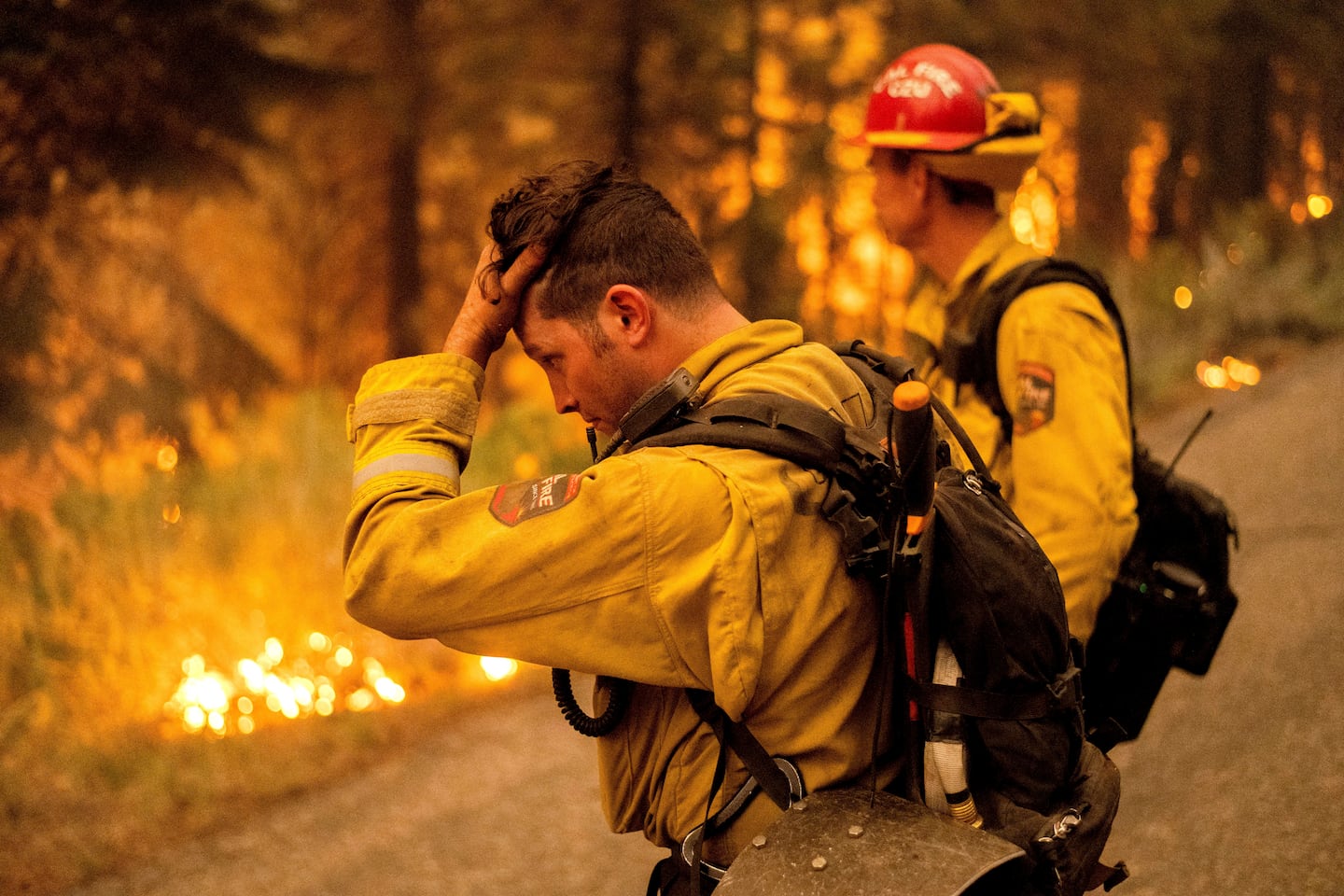
The Fort McMurray wildfire, which drove the largest, most rapid evacuation due to fire in modern times and hobbled Canada’s multibillion-dollar petroleum industry for months, was seen by most Americans (if they saw it at all) as remote and anomalous — nothing to do with them. Though it occurred less than a decade ago, that was a more innocent time: Most of the horrific fires we can now reel off by name (Tubbs in 2017, Camp in 2018, Dixie in 2021, Lahaina in 2023, Los Angeles in 2025) had not yet ignited. But time is flying, and we are now a quarter of the way through a historic century during which we will see the cresting of fossil fuel use and of human population, in conjunction with a cataclysmic loss of species and the integrity of ecosystems — marine and terrestrial alike.
These are not abstract events lurking in the future; they are underway, and they are accelerating in real time. As we go about our lives, rapidly increasing excess heat generated by fossil fuel emissions is pushing the limits of human endurance. One hundred and twenty-two degrees F. is an increasingly common summer temperature, and not just in the Middle East.
Temperatures like this are lethal to humans and to many other species, but fire thrives in them. And there is no way for firefighters to combat these superheated, fast-moving fires.
During the Dixie Fire four years ago, which burned 1,500 square miles of forest in Northern California, embers flew 10 miles, starting new fires where they landed. What enables an ember to do this? Low humidity and high temperatures. Water has little effect on high-intensity wildfires, and fire retardant drops are about as effective as firebreaks — nothing can stop flying embers.
This is the power of increasing atmospheric CO2. What I call “21st-century fires” are hotter, faster, more destructive events that burn longer, grow larger, kill more people, and are harder to suppress. Some also expand aggressively round the clock, due to rising nighttime temperatures. In addition, so-called zombie or holdover fires are now surviving our shorter, warmer winters by smoldering in root systems to emerge the following spring.
According to the California Department of Forestry and Fire Protection, eight of California’s most destructive fires have occurred in the past five years alone.
This is exhausting and, clearly, dangerous for firefighters. When the Carr Fire broke out in California in 2018, many local firefighters worked nonstop for days — just as their counterparts had done at Fort McMurray two years prior and as firefighters have continued to do during every major fire since. These changes in fire behavior have, in turn, changed the role firefighters play in these events.
In 2021, a ferociously hot and stubborn fire burned through California’s Sequoia National Park for four months, killing thousands of the majestic giant trees. Like redwoods, sequoias can live for millennia, in large part because they evolved to withstand fire, even freak thousand-year events. But 21st-century fire is different. Hotter and drier now, the atmosphere has been tilted in fire’s favor.
It’s hard to appreciate the extraordinary energy generated by such a fire if you haven’t experienced one yourself, but a lot of their energy manifests as radiant heat. For all you poets and bankers out there, radiant heat is the heat that tells you not to touch the candle’s flame. It is invisible, and it moves at the speed of light. The radiant heat coming off the leading edge of a 21st-century California wildfire can hit 900 degrees, hotter than the surface of the planet Venus.
Radiant heat projects, which means it superheats future fuels — including you, your car, your camp, the forest — to the point that they can combust even before the fire arrives. So otherworldly were the fire conditions during Australia’s Black Saturday Fires in 2009 that people and animals were killed by radiant heat alone from hundreds of meters away, as if they had been felled by a death ray. Water dropped or sprayed under these conditions will vaporize hundreds if not thousands of feet before reaching any actual flame.
It’s not just our forests; our neighborhoods are also more flammable because they have been so thoroughly infiltrated by petroleum products — to the point that the modern home is composed almost entirely of volatile hydrocarbons. When you superheat plastic garbage cans, polyurethane mattresses and sofa cushions, synthetic rugs, linoleum floors, vinyl siding, and tar shingles, they off-gas, turning every room into a combustion chamber.
The same thing happens in superheated forests. Those sheets and towers of flame we see igniting high above the treetops are clouds of hydrocarbons exploding like vapor in a gas can — just as they do inside the modern, petrochemical-infused home. This is why 50-ton, two-story, $750,000 houses in Fort McMurray, Alberta, deep in Canada’s subarctic, were observed burning to their foundations in six minutes, leaving nothing but the metal shells of heavy appliances and piles of nails. No one who’s witnessed this — in Fort McMurray, in Los Angeles, or in Valparaiso, Chile, last year — was prepared for how fast these fires move, or how quickly they can make large, expensive objects disappear.
Even as fossil fuels enable the fabulous lifestyle so many of us are still trying to enjoy, they take those gains away, endangering all the beings — trees, rivers, and humans alike — that enjoy fireprone, hydrocarbon-rich areas like New England.
The hundreds of fires that tormented the Northeast last November ignited during the hottest year in recorded history.
This year, atmospheric CO2 levels exceeded 430 parts per million for the first time in about 10 million years. The longer the world’s major economies (not to mention our personal finances and transportation choices) remain hostage to the fossil fuel industry, the worse these fires, floods, heat waves, and droughts are going to get, the busier first responders are going to be, and the more evacuations, heartbreak, and PTSD we are all going to suffer.
The reason this is happening can be summarized by one word: fire. I don’t mean wildfire, I mean fossil fuels: The principal reason we labor (and lobby) so hard to liberate coal, oil and gas from the ground is so we can burn it. In other words, if you’re in the fossil fuel industry, you’re in the fire industry, which means you’re in the CO2 industry.
Given this, the most accurate way to calculate the debt incurred by our largely fire-powered economy is by measuring CO2. If we understand excess anthropogenic CO2 as debt, then excess heat is the interest on that debt. Starting around the year 2000, when CO2 levels were approaching 370 parts per million, the rate of global temperature rise accelerated, becoming more noticeable to the general public.
What the thermometer is telling us is that our CO2 debt level has become unsustainable, and the “interest” unpayable — to the point that we have entered the default zone. Typically, when we default on a loan, the bank calls in the debt; it might even repossess our stuff. This is one way to understand the steady increase in fossil fuel-enhanced weather disasters: These intensifying floods, fires, heat waves, and storms are the Bank of Nature’s repo men coming to collect on that debt — “repossessing” our homes, our cars, our towns, our summer retreats, even our very lives.
Today, a quarter of Americans live in states and municipalities suing oil companies for their persistent bad faith regarding the climate impacts of their industry. A comparable number of Americans have lost, or are in danger of losing, insurance coverage for floods and fires made measurably worse by that same industry.
A more positive and forward-looking way to interpret this dire and pivotal moment is as a stern invitation to mature — out of petroleum-powered, AI-enhanced capitalism’s dangerous delusion that nature is some kind of bottomless trust fund that we can draw on at will, with no consequences; and that we are somehow in charge.
I don’t care what business you’re in, virtual or actual, nature owns at least 51 percent of it. Until we recognize that the natural world has a controlling stake in everything we do, it will continue to remind us of this fact in progressively more violent ways. And it will continue collecting on our debt.



